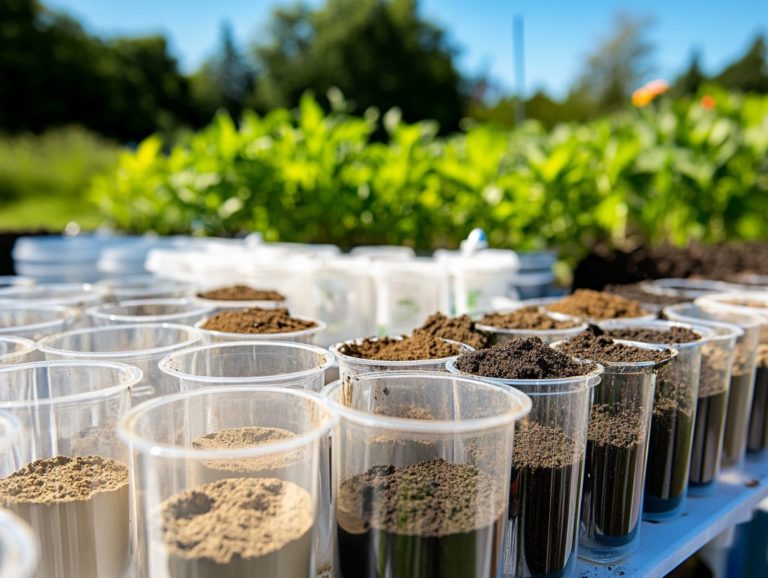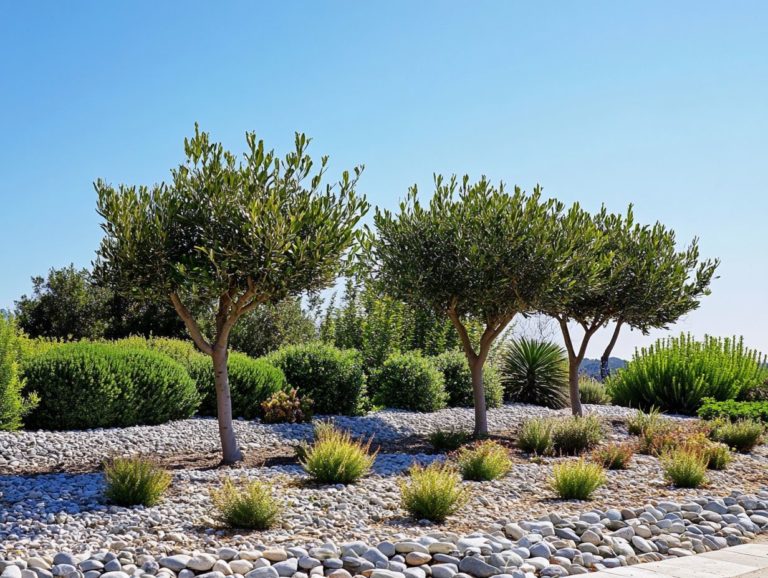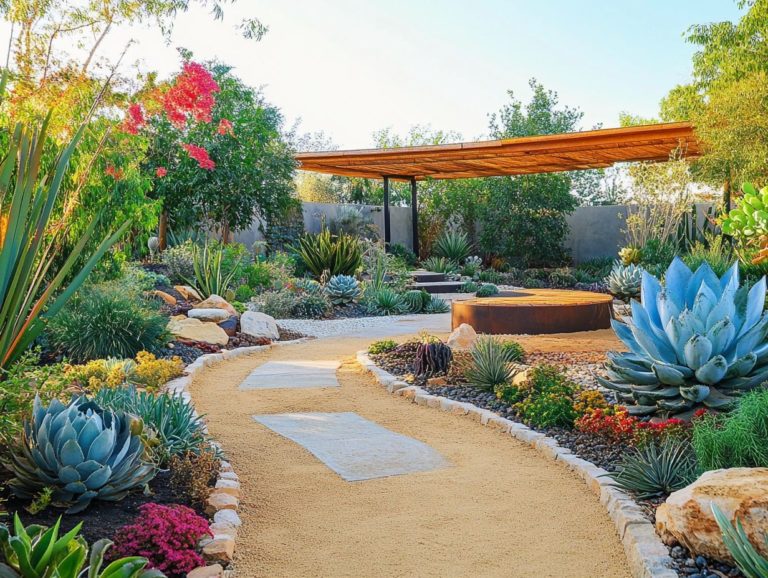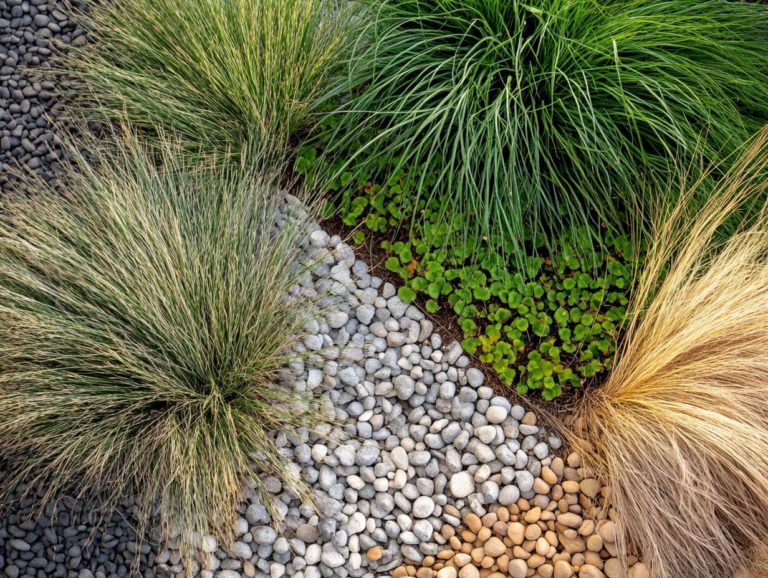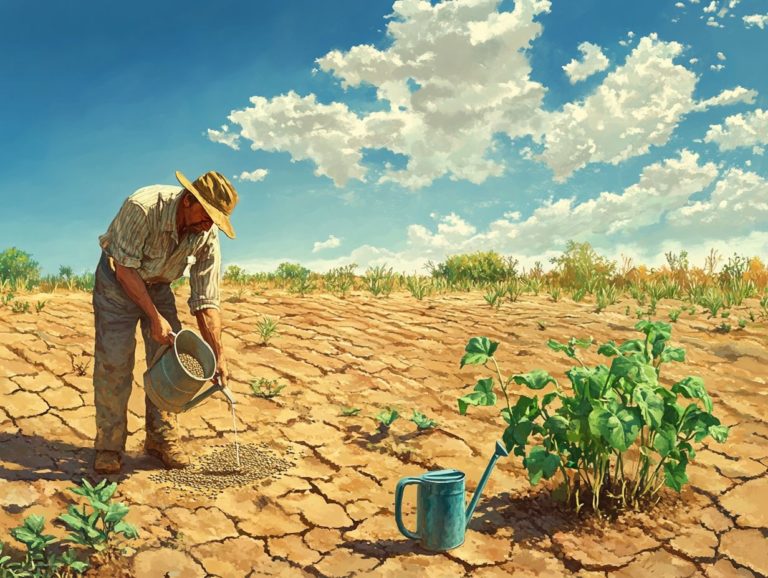5 Common Mistakes in Drought Landscaping
Drought landscaping is becoming increasingly popular as homeowners seek sustainable, water-efficient gardening solutions. This trend is driven by a focus on resource efficiency and the need to reduce maintenance needs.
However, many individuals make common landscaping mistakes that can jeopardize their efforts. This article highlights five common drought landscaping mistakes, including neglecting site preparation, overlooking ideal plant selections, and making poor plant choices.
We will also discuss how to create a flourishing drought landscape that conserves water and enhances your outdoor space. Consider factors like mature size and planting depth for each selection.
Let s dive into how you can create a breathtaking, eco-friendly garden today! Continue reading to unveil the secrets to successful drought landscaping, including pruning techniques and seasonal considerations!
Contents
- Key Takeaways:
- 1. Overlooking the Importance of Soil Preparation
- 2. Not Choosing Drought-Tolerant Plants
- 3. Not Utilizing Mulch
- 4. Not Considering the Sun and Shade Patterns
- 5. Not Having a Proper Irrigation System in Place
- How Can Drought Landscaping Benefit the Environment?
- Frequently Asked Questions
- What are the 5 common mistakes in drought landscaping?
- Why is overwatering a common mistake in drought landscaping?
- How do non-native plants affect the environment in drought landscaping?
- Why is soil health important in drought landscaping?
- What is improper mulching, and why is it a mistake?
- What are some effective water-saving techniques in drought landscaping?
Key Takeaways:

- Proper soil preparation is crucial for a successful drought landscape.
- Choosing drought-tolerant plants is essential to conserve water and maintain a beautiful landscape.
- Using mulch helps reduce water evaporation and promotes soil moisture retention.
1. Overlooking the Importance of Soil Preparation
Soil preparation is an essential yet often overlooked part of successful landscaping. It profoundly impacts the health of your plants, including trees and shrubs. This is especially true in challenging climates like Florida, where resource efficiency is crucial.
The condition of your soil directly affects drainage. Proper drainage prevents issues like root rot, a condition where plant roots decay due to excess moisture. By ensuring proper site preparation, you can optimize the soil’s structure, texture, and fertility, creating an ideal environment for healthy plant growth.
To prepare your soil effectively, start by conducting tests that check nutrient levels and pH. Once you have that information, improve your soil with organic matter to enhance its texture and drainage capabilities. Avoid compaction and ensure ample aeration to reduce landscaping pitfalls and invasive plants. This will foster a vibrant garden that flourishes in harmony with its surroundings.
2. Not Choosing Drought-Tolerant Plants
Failing to choose drought-tolerant plants can increase your maintenance needs and waste resources, especially in regions like Florida. Selecting options like hydrangeas or plants suited for a Mediterranean garden is essential.
Opting for plants that thrive in dry conditions allows you to conserve water and lessen the frequency of garden upkeep. When cultivating your landscape, consider how local climate conditions affect your plant selection. This ensures resilience against challenges such as drought and extreme temperatures.
For instance, native species like Florida Anise or Texas Sage are visually appealing and highly adaptable. They require minimal care while warding off invasive species.
By making informed choices, you can create sustainable landscapes that thrive with minimal resources, contributing to healthier ecosystems.
3. Not Utilizing Mulch
Neglecting to use mulch can impact soil conditions and lead to increased resource use, higher maintenance demands, and a less attractive garden.
Applying mulch, such as organic options like wood chips or shredded leaves, significantly improves soil health. It retains moisture and regulates temperature, creating a stable environment for your plants. This moisture retention translates to less frequent watering, reducing water consumption and lowering your utility bill. Organic mulches like wood chips or shredded leaves enrich your soil with essential nutrients as they break down over time.
Various types of mulch, such as decorative stones or colored bark, offer functional benefits and enhance the visual appeal of your landscape. Choosing the right mulch helps suppress weeds and protects roots, contributing to the beauty and resilience of your garden.
Have you tried drought landscaping? Share your experiences or tips below, and be sure to check out our article on 5 mistakes to avoid in soil conservation as you join our community of eco-conscious gardeners!
4. Not Considering the Sun and Shade Patterns
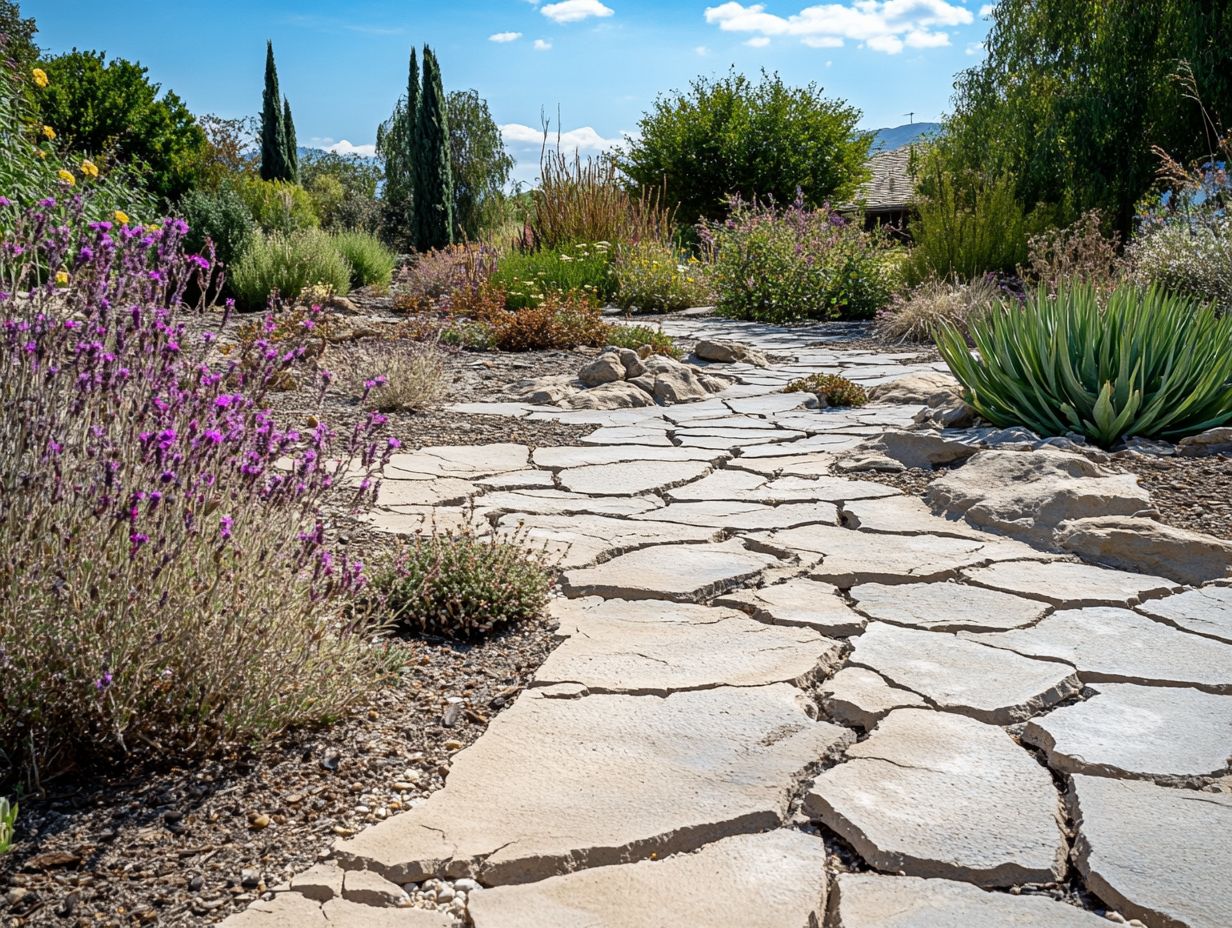
Neglecting to consider sun and shade patterns in your landscaping can lead to poor plant choices. Many plants have specific light requirements that are crucial for their growth, so it’s beneficial to review tips for maintaining your drought garden.
Understanding these light conditions is vital for crafting a sustainable and visually captivating outdoor space. For example, areas bathed in sunlight are perfect for sun-loving groundcovers like sedum or creeping thyme. These plants not only thrive but also add vibrant color to your landscape.
On the flip side, shaded areas may call for hardier options such as ferns or hostas that flourish in cool, filtered light.
Take a moment to watch how the sun moves across your landscape. Notice where your plants will thrive and where the dappled shade from trees provides refuge. By analyzing these elements, you can make informed decisions about plant placement, ensuring harmony within your garden’s ecosystem.
5. Not Having a Proper Irrigation System in Place
A well-designed irrigation system is essential for maintaining healthy landscapes, especially in regions like Florida, where drought conditions can challenge soil health and plant vitality. Yet, many homeowners overlook this crucial aspect.
Proper irrigation conserves water and promotes plant growth, reduces weeds, and lowers maintenance costs over time. As a homeowner, you may find yourself exploring options like drip systems, sprinklers, and soaker hoses. Each offers unique benefits tailored to various landscape types.
To determine which system aligns best with your needs, evaluate factors such as soil type, plant requirements, and local weather patterns. Ensure installation follows a clear plan for efficient coverage and minimal water wastage. This method transforms your outdoor space into a thriving oasis you can enjoy every day!
How Can Drought Landscaping Benefit the Environment?
Drought landscaping provides a wealth of environmental benefits, promoting resource efficiency through water-saving techniques and smart plant selection that thrives in low-water conditions.
This approach cultivates habitats for wildlife and helps curtail the spread of invasive species like pests. By incorporating native plants such as succulents and drought-resistant perennials, you can reduce reliance on chemical fertilizers and pesticides, fostering biodiversity in your outdoor space.
Additionally, thoughtfully designed drought landscapes improve soil health by minimizing erosion and encouraging healthier microbial activity. Adopting principles of water-efficient landscaping not only conserves water but also significantly reduces maintenance needs.
Consider the inspiring examples of community parks that have embraced these practices, showcasing vibrant plant life while making efficient use of limited water resources.
What Are the Key Elements of a Successful Drought Landscape?
Key elements of a successful drought landscape revolve around strategic choices in plant selection. Consider implementing 5 ways to enhance drought landscapes to ensure that your choices harmonize with local climate conditions.
Use smart watering systems and maintenance practices that enhance soil health while minimizing resource use. Think about the native flora that flourishes in your area; these plants are already adapted to the environment and need less water.
By opting for drip irrigation, a system that delivers water directly to the roots, you can dramatically reduce water wastage. This allows for deep root penetration while keeping consistent moisture levels.
Don t overlook the benefits of mulching, which helps retain soil moisture and suppress weeds. This ultimately decreases the frequency of maintenance tasks.
Regular soil testing and tailored amendments based on specific nutrient needs can further bolster plant resilience. This paves the way for a beautifully sustainable landscape that conserves water and nurtures local biodiversity.
What Are the Different Types of Drought-Tolerant Plants?
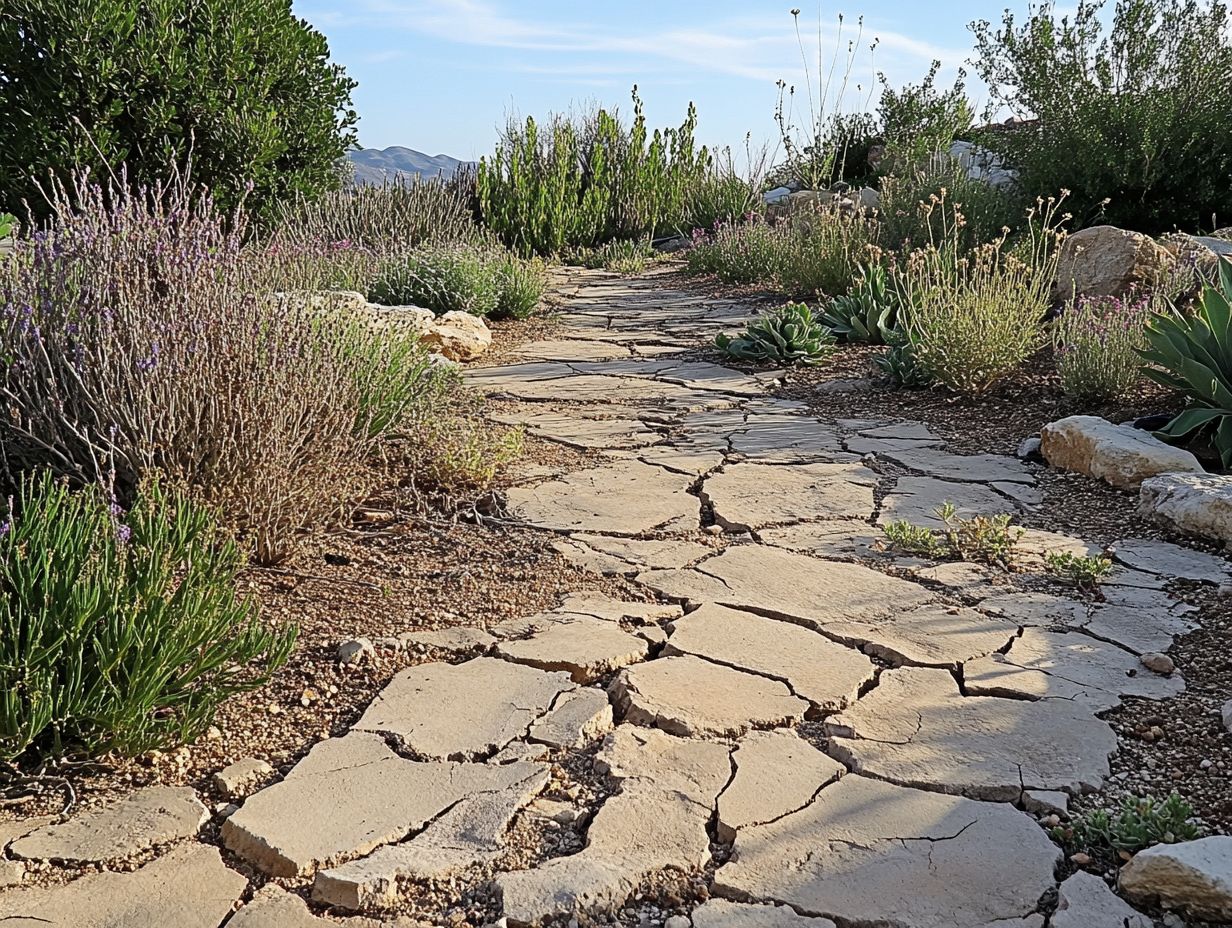
You have an impressive selection of drought-tolerant plants for your garden, including various succulents and shrubs. Options like hydrangeas and other species designed for Mediterranean climates thrive even in challenging soil conditions and limited water availability ideal for warmer regions like Florida.
But don t stop at hydrangeas. Explore a variety of succulent plants that conserve water while adding unique textures and vibrant colors to your landscape. For arid regions, consider options like agave and yucca, which require minimal irrigation and deliver striking architectural features.
If you re in a milder climate, lavender and ornamental grasses offer tremendous versatility. They attract pollinators and provide a low-maintenance aesthetic. Each of these plants plays a vital role in sustainable landscaping, significantly reducing the need for frequent watering.
These options are perfect for environmentally-conscious gardeners like yourself. Ready to transform your garden? Start exploring these beautiful drought-tolerant plants today!
How Can a Drought Landscape Be Maintained?
Maintaining a drought landscape requires a keen understanding of your plants’ unique needs. To effectively manage these needs, consider utilizing 5 essential tools for drought landscaping. Optimize your irrigation system for maximum resource efficiency, and ensure that soil conditions remain favorable for plant health during dry spells.
Craft a tailored irrigation schedule that aligns with natural rainfall patterns. This can dramatically reduce water waste and make a meaningful difference.
Incorporate soil amendments like compost or mulch to enhance moisture retention and improve nutrient availability. This provides your plants with the vital support they need to thrive.
Consider seasonal care tips such as pruning and selecting drought-resistant native species. These strategies allow you to cultivate a resilient garden that flourishes even in challenging conditions.
Understanding and implementing these approaches not only aids in the immediate care of your plants but also nurtures an environment capable of withstanding extended periods of low precipitation. This ensures sustainability for years ahead.
What Are the Common Myths About Drought Landscaping?
Despite its many advantages, drought landscaping often comes with misconceptions that could steer you off course. It’s easy to think that such landscapes require little maintenance or rely solely on invasive plants; however, there are essential tips for drought landscaping that can help you create a beautiful and sustainable environment.
In truth, effective drought landscaping demands thoughtful planning and ongoing care, much like any other garden design. You might assume that once established, these landscapes need little more than an occasional splash of water. However, avoiding common mistakes in drought plant care and understanding their growth habits is key to achieving long-term success.
Opting for native species can significantly boost your landscape’s resilience while providing essential habitats for local wildlife. Native plants are perfectly suited to your local climate and soil, which not only conserves water but also fosters biodiversity.
This creates a vibrant outdoor environment that benefits both you and the surrounding ecosystem.
What Are Some Examples of Successful Drought Landscapes?
Explore the amazing world of drought landscapes! These landscapes showcase resource efficiency and carefully chosen plants that boost aesthetic appeal and wildlife habitats in water-scarce regions like Florida.
You’ll often encounter native drought-resistant plants such as Gulf Coast muhly grass and firebush. These plants thrive on minimal water and provide essential food sources for local pollinators.
Xeriscaped gardens create a vibrant mix of colors and textures. They also use rocks and mulch to cut down evaporation and prevent soil erosion.
Incorporating rain gardens boosts water capture and infiltration. These landscapes show how smart design and nature can work together for sustainability and biodiversity.
Frequently Asked Questions
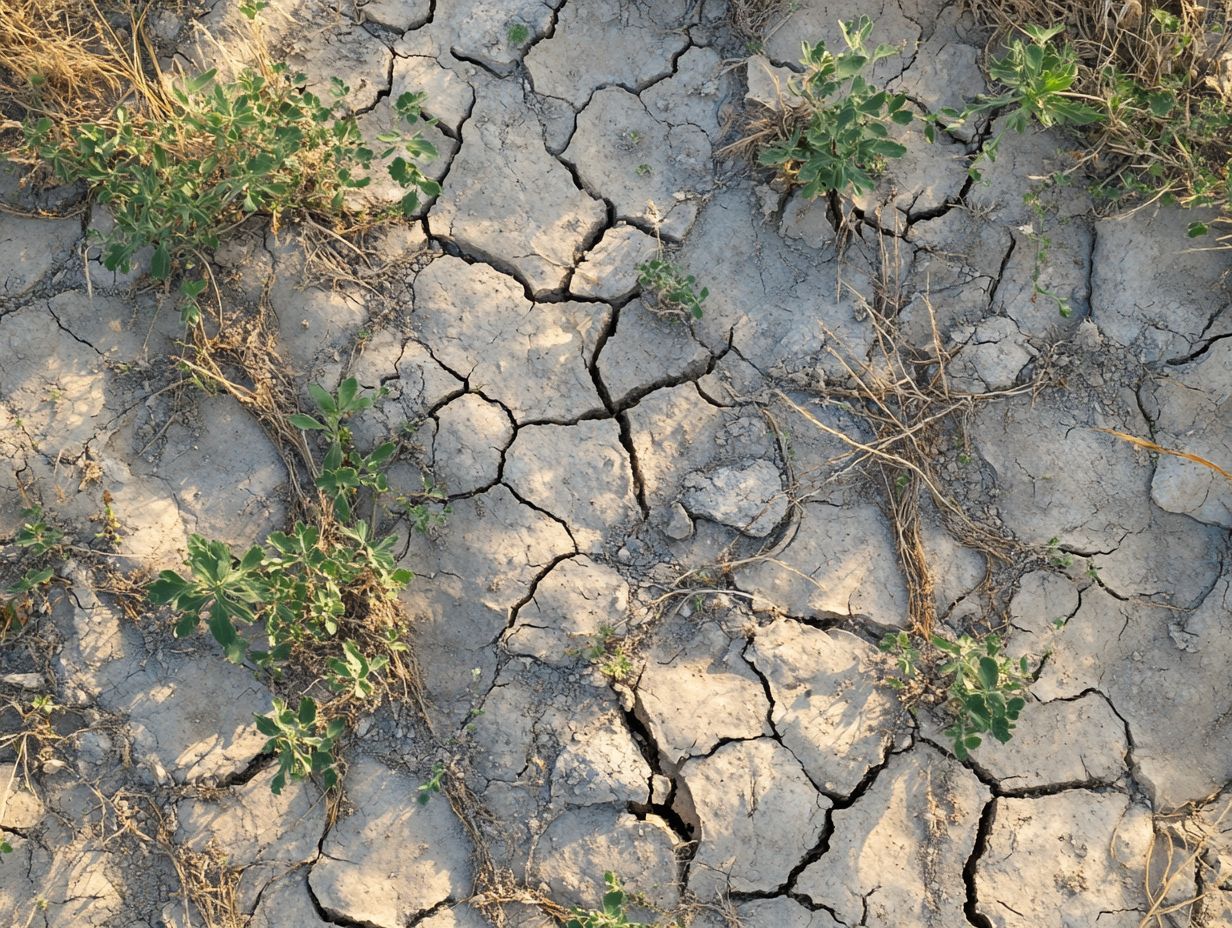
What are the 5 common mistakes in drought landscaping?
The five common mistakes are: overwatering, using non-native plants, neglecting soil health, improper mulching, and not using water-saving techniques.
Why is overwatering a common mistake in drought landscaping?
Overwatering wastes water and makes plants reliant on constant irrigation.
How do non-native plants affect the environment in drought landscaping?
Non-native plants often need more water than native ones, leading to waste and disrupting local ecosystems.
Why is soil health important in drought landscaping?
Healthy soil retains moisture better, reducing the need for watering and helping plants thrive.
What is improper mulching, and why is it a mistake?
Improper mulching whether too much or too little can stunt plant growth and reduce water absorption.
What are some effective water-saving techniques in drought landscaping?
Effective techniques include drip irrigation, collecting rainwater, using drought-resistant plants, and applying mulch to retain soil moisture.

